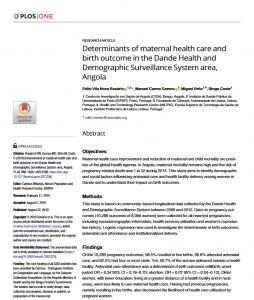
Objectives
Maternal health care improvement and reduction of maternal and child mortality are priorities of the global health agenda. In Angola, maternal mortality remains high and the risk of pregnancy-related death was 1 in 32 during 2015. This study aims to identify demographic and social factors influencing antenatal care and health facility delivery among women in Dande and to understand their impact on birth outcomes.
Methods
This study is based on community–based longitudinal data collected by the Dande Health and Demographic Surveillance System between 2009 and 2015. Data on pregnancy outcomes (10,289 outcomes of 8,066 women) were collected for all reported pregnancies, including sociodemographic information, health services utilisation and women’s reproductive history. Logistic regression was used to investigate the determinants of birth outcomes, antenatal care attendance and institutionalised delivery.
Findings
Of the 10,289 pregnancy outcomes, 98.5% resulted in live births, 96.8% attended antenatal care, and 82.5% had four or more visits. Yet, 50.7% of the women delivered outside a health facility. Antenatal care attendance was a determinant of birth outcomes (stillbirth: unadjusted OR = 0.34 95% CI = 0.16–0.70; abortion: OR = 0.07 95% CI = 0.04–0.12). Older women, with lower education, living at a greater distance of a health facility and in rural areas, were less likely to use maternal health care. Having had previous pregnancies, namely resulting in live births, also decreased the likelihood of health care utilization by pregnant women.
Conclusions
The study identifies relevant social determinants for the utilisation of antenatal care, place of delivery and their impact on birth outcome, thereby providing insight on how best to address inequities in health care utilization.